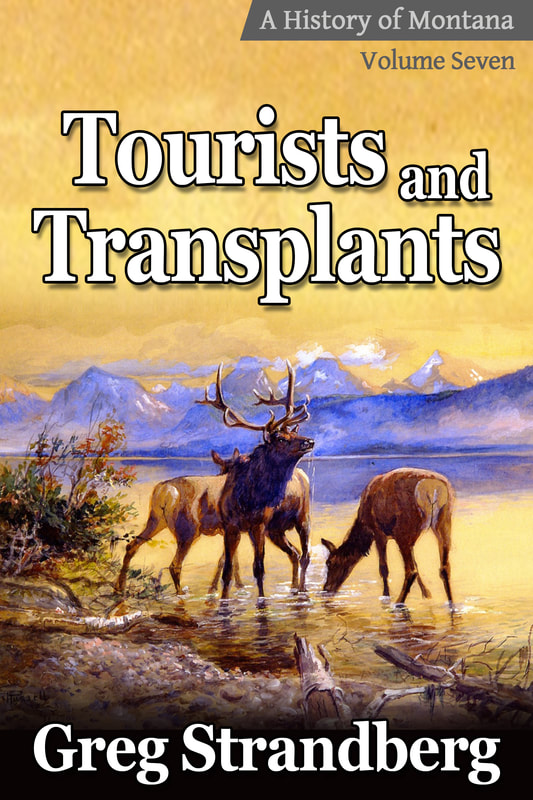By the late-1930s, Joe Howard had been working as a newspaper reporter in Great Falls for fifteen years.
He’d had success - the city’s people liked his work, as did those living in the rural areas. The Indians respected him for respecting them. And national audiences finally caught a glimmer of what Montana was really like through the national magazines that published Howard’s work.
But some thought he should do more.
Bud Guthrie was one that encouraged Joe to write more than just newspaper and magazine articles. So he did, on evenings and weekends for five years, mostly at his cabin. A book was produced. He sent it to Yale University Press, and they put it out in 1943.
The book is Montana: High, Wide, and Handsome. It’s 340-pages long and divided into 27 chapters that are themselves divided into 7 parts: Prairie, and prophet, prospector, puncher, plow, panic, and at long last, planning.
“The state’s isolation is an old, old story and responsible for much of its economic and social maladjustment,” Howard writes early in the work.
The book’s take on the corporate climate in Montana angered many of the state’s influential citizens. In the early years, it was often hard to find a copy of the book. In Butte, copies could only be found in bars and only “if you asked the right way.”
Time changes our outlook, and by 1981 the book was voted the best book ever written about Montana by Montana Magazine readers. By 2008, eight editions of the book had been printed.
On of my favorite chapters from the book is Chapter 22: Man on Horseback. The chapter is about 7 pages long and profiles Dan McKay and his quest to split up as many Montana counties as he could. I gave you that history of our 56 counties several years ago. Of course, few can put it more lively than Joe did:
“The county seat fights were terrific. Some farmers slew each other with pitchforks, businessmen battled in saloon and street. A few times, on hostile ground, Dan actually risked his life; but he always escaped unmarked.”
Howard wasn’t fond of bankers. For a period of ten years beginning in the 1910s, national banks that were members of the Federal Reserve came into Montana and drove the state banks out of business. When 176 of these national banks were instituted in 1917, Montana got forty-one of them. Spurious lending practices guided them.
“It is true that for a few years almost anyone could set up a bank in Montana and almost anyone could get a loan. As Garet Garrett put it, money went to people the bankers knew nothing about ‘except that they owned land, wore spurs, and smelled of cattle.”’
Not enough attention is paid to Howard’s aversion of the federal banks, and the man that shoved them down Montana’s throat, Woodrow Wilson, though several later chapters in his book are dedicated to this.
Howard details how Wilson signed the Federal Reserve Act into law in late-1913 as a “Christmas gift to the American people.”
Ten years later, over a third of Montana’s banks had closed - “a total of 191 - and their depositors had lost about $30,000,000 in four years.”
We do pay attention to Howard’s ‘zeal’ in going after the Company, even though Anaconda Mining/Amalgamated only appears in a few chapters, and is only mentioned in the book’s index nine times.
In fact, the longest continuous number of pages that Howard devotes to the Company comes to us in Chapter 23: “A Russian Jew Named Levine…”
Here we learn of the brave UM professor that published a 141-page essay in 1919 called The Taxation of Mines in Montana.
Louis Levine was the man’s name. He’d been told to produce the report by none other than UM’s chancellor, the boss in charge. But when that boss found out what Levine was writing, he warned Levine not to publish the essay. Levine did it anyway, and was promptly fired.
To Howard, this made perfect sense - UM was part of the state, and the state was controlled by the Anaconda Mining Company. Why would Anaconda want a report coming out that said total metal mining in Montana was $20 million but the companies were only paying $13,000 in taxes on that production?
Well, you wouldn’t. A furor came out over this, and Levine got his job back two months later. It’d take a few years more, but Anaconda would have to start paying more taxes, too.
Beginning in 1946, Joe started working on a novel. He got quite serious about it, even teaching himself to read French so he could better discern the letters of his main subject, the Metis people in Canada.
Howard got two Guggenheim Fellowship grants to work on the novel, in 1947 and 1948. He also found a publisher for the book, even though it wasn’t done. He wrote 60,000 words before he came to the conclusion that he wasn’t a novelist. The manuscript went into the trash. He started over from scratch, changing the novel’s name from “Falcon’s Song” to “Strange Empire.” Both 1949 and 1950 came and went, and the novel remained a work in progress.
At the same time, Howard was directing an annual writer’s conference each summer in Missoula while producing articles for national magazines. He requested several extensions on the novel from his editors, and they in turn requested substantial rewrites to make the book more interesting.
By 1951, Howard was still laboring on the novel. After finishing that year’s writer’s conference in Missoula, Howard drove himself back to Great Falls. On the way, he had a heart attack and died. He was just 45-years-old.
Obituaries appeared in major publications around the country. The Minneapolis Star wrote a 4-part series, calling him “Mr. Montana.” Bernard DeVoto called him “the spokesman of the West.”
By 1952, Howard’s novel Strange Empire was finally published.
In 1979, Joe Howard’s name was added to the Gallery of Outstanding Montanans.
“He set a lifelong goal of exploring the truth behind events in the state’s history,” PBS said of him. “He did not avoid controversial issues or back down from prominent leaders.”
Howard, Joseph Kinsey. Montana: High, Wide, and Handsome. Yale University Press: New Haven, 1943. p 17, 26, 33, 202, 228-9, 238, 254-7, 259-60, 272-4, 282, 284-5, 292-3, 296, 299-300, 316.
“Joseph Kinsey Howard: A Life Outside the Margin.” Montana PBS. 4 June 2009. https://www.montanapbs.org/programs/JosephKinseyHowardALifeOutsideTheMargins/

